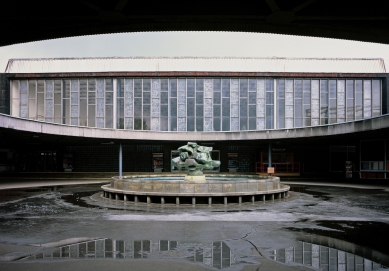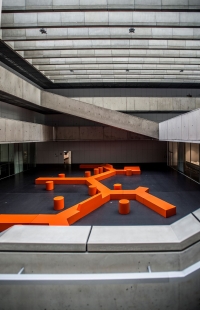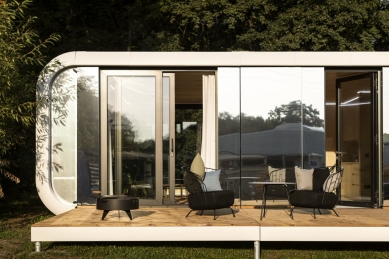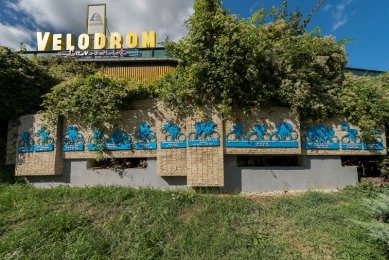
On Friday, the Architecture Day Festival 2021 begins
After 300 events in 80 cities and municipalities across the country and in Slovakia, the Architecture Day festival invites you from Friday, October 1st. Especially over the weekend of October 2nd and 3rd, it offers a rich and free-access program of excursions into normally inaccessible buildings, walks, as well as bike rides, train trips, or boat trips with engaging commentary. Aiming to highlight quality architecture and present it in broader contexts, it draws attention to historical gems as well as contemporary architecture, forgotten places, former factories, and sacred architecture. This year, the festival embarks on the main thematic line of “transport connections” along various current and past routes, focusing on train stations and other buildings associated with transport. The second key theme of this year’s edition commemorates the 150th anniversary of the birth of Jan Kotěra, the founder of modern architecture in our country, at various locations throughout the republic.
As part of the festival, which covers all regions of the republic, interested parties can explore contemporary architecture and visit, for example, the KOMA Modular center of modular architecture in Vizovice, both buildings of ČSOB in the Prague district of Radlice, and older gems such as Veleslavín Castle in Prague 6, the garden of Villa Tugendhat, the Brno Velodrome, or take walks through train stations in Ostrava, the former Baťa worker's colony in Sezimovo Ústí, or the defunct tram lines in Liberec. The festival also offers a range of lectures, discussions, theatrical performances, exhibitions, and workshops. There is also a program for children. Running parallel to Architecture Day, this year marks the tenth edition of its sister festival, Film and Architecture. The complete program is available at www.denarchitektury.cz.
Transport Connections
The routes and connections, both vanished and still existing, that weave through our cities and the influence of transport on the shaping of our cities and human movement within them are the main theme of the 11th edition of the festival. It will focus on railway lines, tramways, metro routes, bridges and footbridges, as well as the regulation of automobile transport and of course related transport constructions including train stations or harbors. It examines land transformations over time, linking paths in the landscape between cities and villages or the buildings themselves. In Prague, the festival will explore, for example, the recently discontinued train line from Strašnice to Vršovice, the endangered Hlávka Bridge, the recently renovated viaduct in Karlín, will head towards the forgotten and abandoned Vyšehrad train station, or delve into the art of the Prague underground. The theme of transport also resonates in the regional programs. In Litoměřice, for example, we will trace the trails of the Austrian Northwestern Railway, which significantly altered the face of Litoměřice during its construction in the 1870s and then in the 1950s. Liberec will offer a walk along the paths of defunct tram lines, while in Opava the festival will visit the local electric current transformer station, whose fate is tied to the operation of local public transport. In Zlín, we will explore both realized and unrealized projects of transport constructions. In Brno, among other things, interested parties can embark on a guided boat tour on the dam, visit the abandoned velodrome, or evaluate the reconstruction of Zvonařka station. In Ostrava, the festival will focus on three train stations over time. In Olomouc, the Architecture Day festival will offer a ride on a local train called Hanácká střela, a trip to station buildings, and other sites along the route to Náměšť na Hané. In Broumov, the focus will be on the Choceň - Broumov railway line and the phenomenon of field roads, and in Bílovec, transit transport issues will be addressed.
150 Years since the Birth of Jan Kotěra
One of the main thematic lines commemorates the personality of architect Jan Kotěra, whose 150th birthday is celebrated this year, and his influence on the development of modern architecture in our country. The festival will present both Kotěra's constructions and the works of his students. In Prague, it will symbolically stop at the house he built for his family at the border of Vinohrady and Vršovice, then head to his villas in Dejvice and Bubenec, and to the tombstones constructed according to his designs at the Prague New Jewish Cemetery. The buildings of the Faculty of Law and the AVU School of Architecture will also be open to the public. The program will not lack constructions in Hradec Králové, such as the City Museum or the Okresní Dům hotel, where the program will also present Kotěra’s unrealized projects. In Zlín, Baťa's villa will open, the first project of the company’s worker colony that defined the future direction of the entire development of Zlín. In Prostějov, interested parties can visit the National House or go on an excursion to the Old and New Castle in Ratiboř or to Fröhlich's summer villa in Černošice. The personality of Jan Kotěra will also be highlighted in a summary lecture by art historian and rector of UMPRUM Jindřich Vybíral. In Kutná Hora, the program includes a visit to the Teller sugar factory, where both Gothic architecture and the work of Jan Kotěra can be found. As part of the celebrations of 150 years since the birth of the first modernist architect Jan Kotěra, the festival will also visit the Baťa colony in Sezimovo Ústí, which was established during the expansion of the Zlín factory.
Contemporary Architecture
The festival regularly monitors the most current architectural achievements. The program thus appeals to visitors with the Helfštýn Castle, whose reconstruction exceptionally connects contemporary architecture with historical heritage. Enthusiasts of the latest trends and sustainable architecture will be pleased with visits to the KOMA Modular center of modular architecture in Vizovice near Zlín, both buildings of ČSOB in Prague's Radlice, or the Krkonoš environmental education center Krtek. The new building of the Faculty of Humanities in Prague and the newly awarded city hall in Modřice near Brno certainly deserve attention as well.
Industrial Architecture
The shape of cities has also been influenced by the development of industry and technical constructions. The festival returns, for example, to the glass center in Kamenický Šenov or the pre-war hydroelectric plant in Beroun, as well as the art-revived area of the former yarn factory in Kyjov near Krásná Lípa. In Kladno, it will look at the conversion of the Bessemer converter steelworks. A fifteen-kilometer bike ride from Frýdlant will lead through the valley of the Smědá River, passing Renaissance mills, forges, and blacksmith shops, as well as factories, workers' houses, and factory villas from the 19th century. In the abandoned glassmaking settlement Kristiánov near Bedřichov, participants will remember the significance of forest glasshouses in the Jizerské hory. In Prostějov, among other things, it will focus on the object of the former Neher textile factory.
Religious Buildings
The program of Architecture Day regularly offers excursions to sacred buildings. This year, for the 1100th anniversary of the martyrdom of Saint Ludmila, it includes a walk discussing the significance and interior of the neo-Gothic church in Prague's náměstí Míru dedicated to this saint. Furthermore, interested parties in Prague can explore the sacred monuments of Dejvice, visit the Hus Church in Vršovice, or the Emmaus Monastery. In Brno, there will be a visit to a new Roman Catholic church dedicated to the blessed Brno native Marie Restituta, with its architect Marek Štěpán. There will also be a unique opportunity in Brno to visit a hidden architectural gem – the chapel in the Palace of Noblewomen. In Opava, it will lead to the Church of St. John, which is reopening to the public after more than eight years.
Film and Architecture
Part of Architecture Day is traditionally the Film and Architecture festival, which will offer about two dozen films in seventeen Czech and Slovak cities. This year's edition, subtitled "Connection," will highlight the important role of architecture in connecting people, places, and cultures, presenting a selection of the most interesting films from international productions that focus on quality architecture or architectural approaches not only to social issues. You can look forward to the unconventional film Spaceship Earth, which describes the futuristic story of simulating life on a space colony, the artistic journey into the sacred work of the renowned Swiss architect titled Mario Botta: The Space Beyond, Body-Buildings, and much more.
The Kruh Association, the founder of the Architecture Day festival, draws upon two decades of experience in the field and long-term cooperation with architects, associations, and institutions in all regions. This has created a network involving 180 cities in the territory of the Czech Republic and Slovakia over ten years. Despite the pandemic, nearly 400 events took place across the Czech Republic and Slovakia last year, attracting around 23,000 visitors.
List of all confirmed locations of the Architecture Day festival
Banská Bystrica, Bardějov, Bedřichov, Benešov, Beroun, Bílovec, Bratislava, Brno, Broumov, Břeclav, Černošice, Červený Kostelec, Česká Kamenice, České Budějovice, Český Krumlov, Dobříš, Frýdlant, Fryšták, Helfštýn, Hodonín, Hradec Králové, Humpolec, Cheb, Jánské Lázně, Jaroměř, Jeseník, Jihlava, Kamenický Šenov, Karlovy Vary, Kladno, Klatovy, Kolín, Krásná pod Lysou horou, Krásné, Kremnica, Kutná Hora, Kyjov u Krásné Lípy, Liberec, Lidice, Litoměřice, Litomyšl, Lomnice nad Popelkou, Mariánské Lázně, Mělník, Mikulčice, Mikulov na Moravě, Nitra, Nový Dvůr, Nymburk, Olomouc, Ondřejovice, Opava, Ostrava, Pardubice, Pavlov, Piešťany, Plzeň, Poděbrady, Praha, Prachatice, Prostějov, Ralsko, Ratboř, Roudnice nad Labem, Řevnice, Sezimovo Ústí, Šumperk, Turnov, Týn nad Vltavou, Ústí nad Labem, Valašské Meziříčí, Vimperk, Vizovice, Volyně, Vrchlabí, Vsetín, Vysoké Mýto, Zábřeh, Zlín, Zvolen, Žamberk, Žatec, Žilina
More information >
As part of the festival, which covers all regions of the republic, interested parties can explore contemporary architecture and visit, for example, the KOMA Modular center of modular architecture in Vizovice, both buildings of ČSOB in the Prague district of Radlice, and older gems such as Veleslavín Castle in Prague 6, the garden of Villa Tugendhat, the Brno Velodrome, or take walks through train stations in Ostrava, the former Baťa worker's colony in Sezimovo Ústí, or the defunct tram lines in Liberec. The festival also offers a range of lectures, discussions, theatrical performances, exhibitions, and workshops. There is also a program for children. Running parallel to Architecture Day, this year marks the tenth edition of its sister festival, Film and Architecture. The complete program is available at www.denarchitektury.cz.
Transport Connections
The routes and connections, both vanished and still existing, that weave through our cities and the influence of transport on the shaping of our cities and human movement within them are the main theme of the 11th edition of the festival. It will focus on railway lines, tramways, metro routes, bridges and footbridges, as well as the regulation of automobile transport and of course related transport constructions including train stations or harbors. It examines land transformations over time, linking paths in the landscape between cities and villages or the buildings themselves. In Prague, the festival will explore, for example, the recently discontinued train line from Strašnice to Vršovice, the endangered Hlávka Bridge, the recently renovated viaduct in Karlín, will head towards the forgotten and abandoned Vyšehrad train station, or delve into the art of the Prague underground. The theme of transport also resonates in the regional programs. In Litoměřice, for example, we will trace the trails of the Austrian Northwestern Railway, which significantly altered the face of Litoměřice during its construction in the 1870s and then in the 1950s. Liberec will offer a walk along the paths of defunct tram lines, while in Opava the festival will visit the local electric current transformer station, whose fate is tied to the operation of local public transport. In Zlín, we will explore both realized and unrealized projects of transport constructions. In Brno, among other things, interested parties can embark on a guided boat tour on the dam, visit the abandoned velodrome, or evaluate the reconstruction of Zvonařka station. In Ostrava, the festival will focus on three train stations over time. In Olomouc, the Architecture Day festival will offer a ride on a local train called Hanácká střela, a trip to station buildings, and other sites along the route to Náměšť na Hané. In Broumov, the focus will be on the Choceň - Broumov railway line and the phenomenon of field roads, and in Bílovec, transit transport issues will be addressed.
150 Years since the Birth of Jan Kotěra
One of the main thematic lines commemorates the personality of architect Jan Kotěra, whose 150th birthday is celebrated this year, and his influence on the development of modern architecture in our country. The festival will present both Kotěra's constructions and the works of his students. In Prague, it will symbolically stop at the house he built for his family at the border of Vinohrady and Vršovice, then head to his villas in Dejvice and Bubenec, and to the tombstones constructed according to his designs at the Prague New Jewish Cemetery. The buildings of the Faculty of Law and the AVU School of Architecture will also be open to the public. The program will not lack constructions in Hradec Králové, such as the City Museum or the Okresní Dům hotel, where the program will also present Kotěra’s unrealized projects. In Zlín, Baťa's villa will open, the first project of the company’s worker colony that defined the future direction of the entire development of Zlín. In Prostějov, interested parties can visit the National House or go on an excursion to the Old and New Castle in Ratiboř or to Fröhlich's summer villa in Černošice. The personality of Jan Kotěra will also be highlighted in a summary lecture by art historian and rector of UMPRUM Jindřich Vybíral. In Kutná Hora, the program includes a visit to the Teller sugar factory, where both Gothic architecture and the work of Jan Kotěra can be found. As part of the celebrations of 150 years since the birth of the first modernist architect Jan Kotěra, the festival will also visit the Baťa colony in Sezimovo Ústí, which was established during the expansion of the Zlín factory.
Contemporary Architecture
The festival regularly monitors the most current architectural achievements. The program thus appeals to visitors with the Helfštýn Castle, whose reconstruction exceptionally connects contemporary architecture with historical heritage. Enthusiasts of the latest trends and sustainable architecture will be pleased with visits to the KOMA Modular center of modular architecture in Vizovice near Zlín, both buildings of ČSOB in Prague's Radlice, or the Krkonoš environmental education center Krtek. The new building of the Faculty of Humanities in Prague and the newly awarded city hall in Modřice near Brno certainly deserve attention as well.
Industrial Architecture
The shape of cities has also been influenced by the development of industry and technical constructions. The festival returns, for example, to the glass center in Kamenický Šenov or the pre-war hydroelectric plant in Beroun, as well as the art-revived area of the former yarn factory in Kyjov near Krásná Lípa. In Kladno, it will look at the conversion of the Bessemer converter steelworks. A fifteen-kilometer bike ride from Frýdlant will lead through the valley of the Smědá River, passing Renaissance mills, forges, and blacksmith shops, as well as factories, workers' houses, and factory villas from the 19th century. In the abandoned glassmaking settlement Kristiánov near Bedřichov, participants will remember the significance of forest glasshouses in the Jizerské hory. In Prostějov, among other things, it will focus on the object of the former Neher textile factory.
Religious Buildings
The program of Architecture Day regularly offers excursions to sacred buildings. This year, for the 1100th anniversary of the martyrdom of Saint Ludmila, it includes a walk discussing the significance and interior of the neo-Gothic church in Prague's náměstí Míru dedicated to this saint. Furthermore, interested parties in Prague can explore the sacred monuments of Dejvice, visit the Hus Church in Vršovice, or the Emmaus Monastery. In Brno, there will be a visit to a new Roman Catholic church dedicated to the blessed Brno native Marie Restituta, with its architect Marek Štěpán. There will also be a unique opportunity in Brno to visit a hidden architectural gem – the chapel in the Palace of Noblewomen. In Opava, it will lead to the Church of St. John, which is reopening to the public after more than eight years.
Film and Architecture
Part of Architecture Day is traditionally the Film and Architecture festival, which will offer about two dozen films in seventeen Czech and Slovak cities. This year's edition, subtitled "Connection," will highlight the important role of architecture in connecting people, places, and cultures, presenting a selection of the most interesting films from international productions that focus on quality architecture or architectural approaches not only to social issues. You can look forward to the unconventional film Spaceship Earth, which describes the futuristic story of simulating life on a space colony, the artistic journey into the sacred work of the renowned Swiss architect titled Mario Botta: The Space Beyond, Body-Buildings, and much more.
The Kruh Association, the founder of the Architecture Day festival, draws upon two decades of experience in the field and long-term cooperation with architects, associations, and institutions in all regions. This has created a network involving 180 cities in the territory of the Czech Republic and Slovakia over ten years. Despite the pandemic, nearly 400 events took place across the Czech Republic and Slovakia last year, attracting around 23,000 visitors.
List of all confirmed locations of the Architecture Day festival
Banská Bystrica, Bardějov, Bedřichov, Benešov, Beroun, Bílovec, Bratislava, Brno, Broumov, Břeclav, Černošice, Červený Kostelec, Česká Kamenice, České Budějovice, Český Krumlov, Dobříš, Frýdlant, Fryšták, Helfštýn, Hodonín, Hradec Králové, Humpolec, Cheb, Jánské Lázně, Jaroměř, Jeseník, Jihlava, Kamenický Šenov, Karlovy Vary, Kladno, Klatovy, Kolín, Krásná pod Lysou horou, Krásné, Kremnica, Kutná Hora, Kyjov u Krásné Lípy, Liberec, Lidice, Litoměřice, Litomyšl, Lomnice nad Popelkou, Mariánské Lázně, Mělník, Mikulčice, Mikulov na Moravě, Nitra, Nový Dvůr, Nymburk, Olomouc, Ondřejovice, Opava, Ostrava, Pardubice, Pavlov, Piešťany, Plzeň, Poděbrady, Praha, Prachatice, Prostějov, Ralsko, Ratboř, Roudnice nad Labem, Řevnice, Sezimovo Ústí, Šumperk, Turnov, Týn nad Vltavou, Ústí nad Labem, Valašské Meziříčí, Vimperk, Vizovice, Volyně, Vrchlabí, Vsetín, Vysoké Mýto, Zábřeh, Zlín, Zvolen, Žamberk, Žatec, Žilina
More information >
The English translation is powered by AI tool. Switch to Czech to view the original text source.




0 comments
add comment
Related articles
0
02.09.2025 | During this year's Architecture Day, 450 events will take place in 136 cities
0
08.09.2021 | Den architektury 2021 - 300 events in 80 cities
0
23.07.2015 | <div class="event">
Architecture 2015 - What Will It Be Like in Five Years?
0
04.07.2014 | The architecture 2014 - Into the streets, among the houses
0
27.09.2011 | The residents of 30 Czech cities will commemorate architecture











